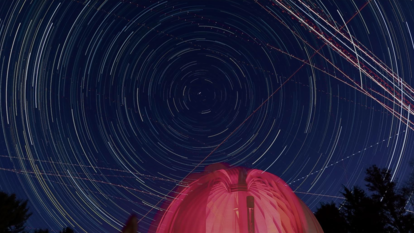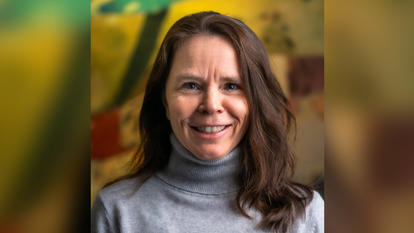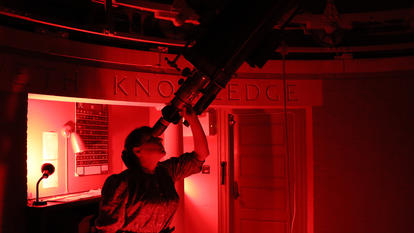Wellesley Looks Deeper into Universe with New Telescope

Wellesley astronomers are looking farther into the universe than ever before. This summer, Whitin Observatory became home to a PlaneWave Instruments CDK700 telescope, which replaced the Sawyer reflecting telescope from 1966. Though it’s only slightly larger than the Sawyer, the new telescope’s mirror delivers brighter images over a larger field of view, while its tracking motors can hold stars steadier in its sights. It can also scan the sky more rapidly.
“If any nostalgic alum asks why we traded in her good ol’ 24-inch, I would ask whether they are still driving around in a 1966 Pontiac!” said Kim McLeod, professor of astronomy.
Students studying astronomy at Wellesley can now use a research telescope even in introductory classes. “This telescope is for students beyond astronomy majors,” said McLeod. “It is extremely unusual for students at a small college, particularly young women in a male-dominated field, to be able to get their hands on a research instrument like this. But at Wellesley, we take this a step further, because even non-science majors have an opportunity to engage in scientific research firsthand with this telescope.”
This semester, students in astronomy classes are using the CDK700 to pick out deep space targets for observation and learning to interpret the images they collect.
The new telescope has already allowed students to engage in two projects that were previously impossible at Wellesley. They are examining gravitationally lensed quasars—distant quasars whose light has been split into two or more images by a foregrounded galaxy—to better understand the effects of space time. “This work enables students to make connections between their astronomy classes and some of the fundamental concepts they are learning in physics,” said McLeod.
Students are also studying the demographics of star clusters for the first time, by taking pictures, making a mosaic of the galaxy structure they are examining, and then studying the distribution and properties of those galaxies. “Exposure times can be shorter for this telescope,” said McLeod. “In effect, the CDK700 sees farther than the old telescope.”
Astronomy majors in particular are thrilled with the new instrument. Over the summer, a group of students took part in NASA’s Transiting Exoplanet Survey Satellite (TESS) mission, whose principal investigators are based at Harvard and MIT. Using the CDK700, they made observations and submitted data sets to NASA, including a possible planet event. They also discovered that a previous NASA observation might be contaminated.
“This research has given me the opportunity to collaborate with others and explore concepts beyond lecture and formal written definitions,” said Hannah Stickler ’22. “It’s exciting for me to be able to say I have contributed to actual science through working on a project like TESS, especially as an undergraduate.”
“Having access to any telescope was a pretty significant factor in my college decision,” said Fiona Powers Ozyurt ’22. “Having access to the PlaneWave is way beyond what I would have thought to ask for. It’s an amazing instrument to work with. The most exciting part is knowing I can contribute to something way bigger than I am, even if my contribution is small.”
Photo: A collection of images from the planewave telescope taken by students in Kim McLeod's ASTR 206 class.



